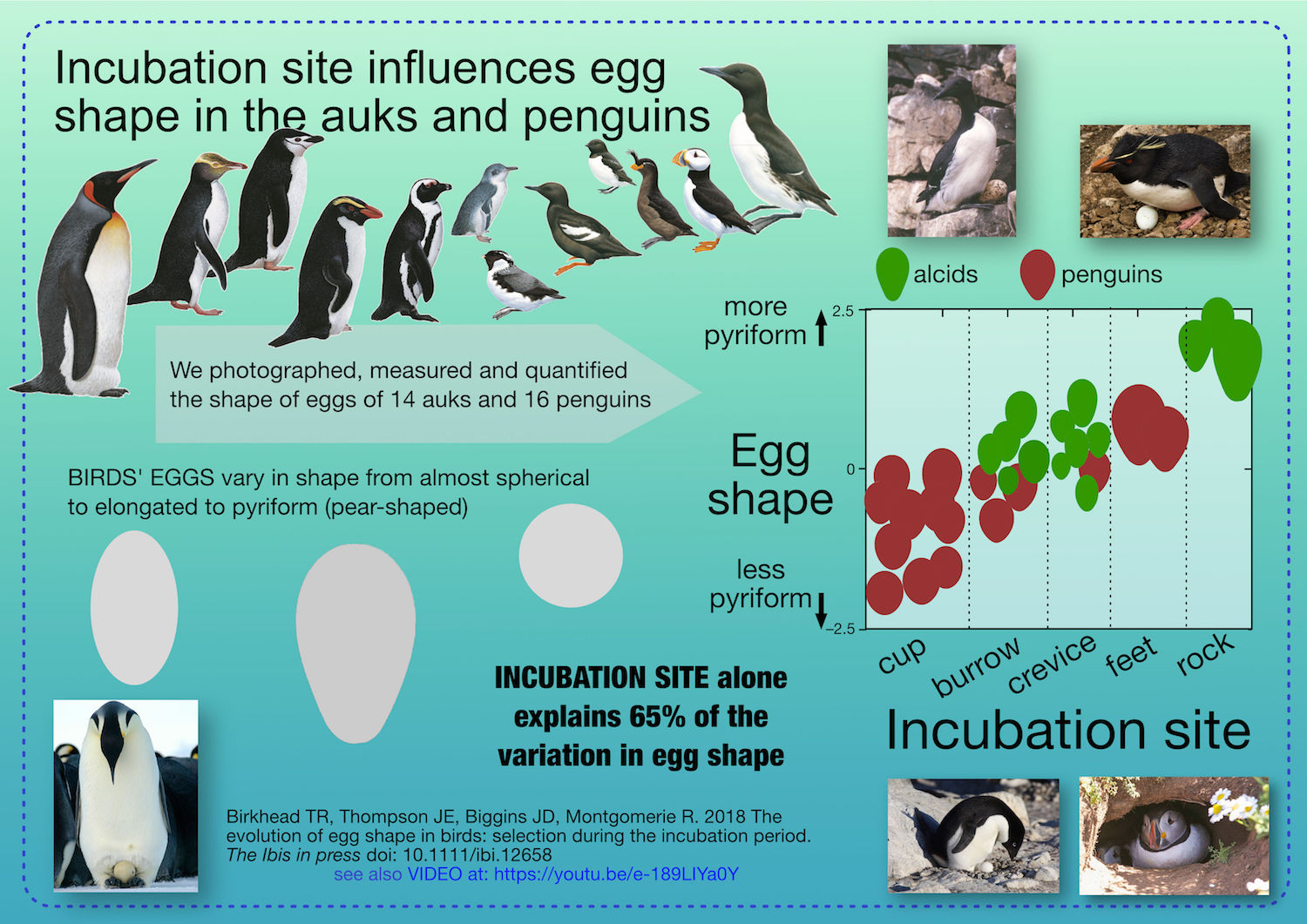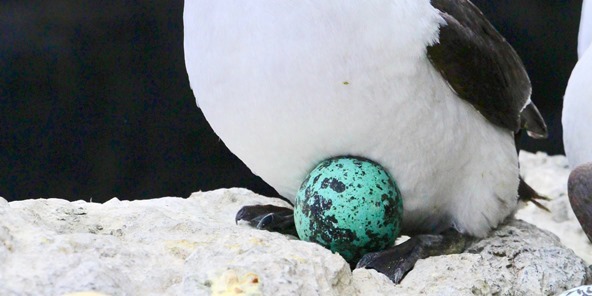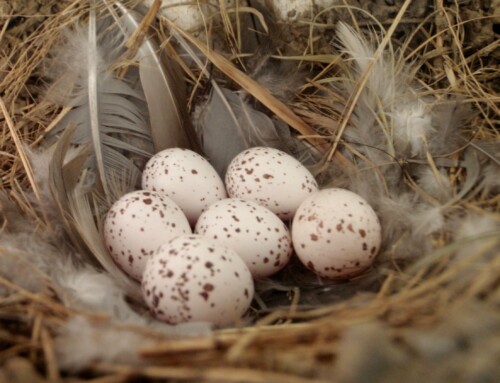Does selection during the incubation period influence egg shape?
LINKED PAPER
The evolution of egg shape in birds: selection during the incubation period. Birkhead, T.R., Thompson. J.E., Biggins, J.D. & Montgomerie, R. 2018. IBIS. DOI: 10.1111/ibi.12658. VIEW
When Thomas Wentworth Higginson’s in 1862 was asked to name the ‘most perfect thing in the universe’ he said: “a birds’ egg”. He must, in part at least, have been referring to the shape of birds’ eggs: smooth, rounded and much more varied than the expression ‘egg-shaped’ ever implies.
In cross section birds’ eggs are perfectly circular, but lengthwise they vary from near-spherical to elongate and often pointed at one or both ends.

The natural variation in egg shape across the 10,000 different bird species has triggered two questions among biologists:
- How does a female bird mould the shape of an egg?
- What is the adaptive significance of variation in egg shape?
Our new paper addresses the second question.
A major impediment to answering this question has been the difficulty of quantifying egg shape. The categories such as oval, elliptical and pyriform used extensively in the 19th-century actually grade into each other and are useful only for general description. More pragmatically, for scientific work, biologists, such as D’Arcy Wentworth Thompson in the early 1900s, began to devise mathematical equations that quantified some (but not all) egg shapes. The pyriform egg of the Common Guillemot Uria aalge egg was considered particularly problematical. Subsequently biologists such as F. W. Preston in the 1950s and 1960s, and D. Baker in 2002, built on Thompson’s foundation to create a range of egg shape indices, although from a practical point of view these were not particularly accessible because of the complexity of the maths.

In June 2017, M. C. Stoddard and colleagues published a study in Science on the topic of the evolution egg shape in birds based on an analysis of a staggering 49,000 eggs from 1400 bird species. They concluded that ‘adaptations for flight may have been critical drivers for egg shape variation in birds’. The media was ecstatic that a long-standing puzzle had finally been solved. National Geographic for example, reported that this analysis showed that ‘birds with the higher hand-wing index — the most efficient and thus best fliers — were the ones with the most asymmetric or elliptical eggs’ and that, ‘as a bird’s body evolved for better flight, the shape of its egg might have adapted with it’. The headline in New Scientist claimed: ‘Bird eggs shaped by the way their mother flies’. The implication — certainly for the media, the public and most scientists — was that factors during egg formation drove the evolution of different egg shapes.
This seemed like a major discovery and we were very excited by the paper as we had been studying variation in the shapes and colours of eggs for some time. A closer look at the Stoddard et al. (2017) paper gave us three causes to question the generality of their conclusions. First, when we teased apart the complexities of their statistical analyses we discovered that ‘flight efficiency’ accounted for just 4% of the total interspecific variation in egg shape and that a lot of interspecific variation in egg shape remained to be accounted for.
Second, the huge sample size was compiled using published (online) photographs of eggs in the Museum of Vertebrate Zoology at Berkeley. Those are useful photographs documenting the collection, but they were not taken for the purpose of measuring egg shape accurately. To do that, one needs to ensure that the eggs are perfectly horizontal, otherwise their shape is often distorted in the analysed image, as you can see in the images below.


Third, Stoddard et al. used Baker’s (2002) method of quantifying egg shape. But, as the authors themselves noted, this method cannot deal adequately with pyriform egg shapes, many of which had to be excluded from their analyses.
Our own studies of egg shape started with finding a practical method — using Preston’s indices (see Biggins et al. 2018) — that accurately quantifies the shape of all birds’ eggs.
We also asked whether factors after egg formation might drive egg shape evolution. Our studies of guillemot eggs (Birkhead et al. 2018) strongly suggested that events associated with incubation are important and other authors have also suggested that selection during the incubation period influences egg shape, as in the case of wader eggs (e.g. Andersson 1978).
Video The evolution of egg shape in birds
The present study, comparing egg shape across the auks (Alcidae) and penguins (Spheniscidae) —two distantly related families with similar ecologies and life histories — confirmed that the type of site in which the egg is incubated has a major effect, with incubation site explaining more than 65% of the variation in shape.

Click image above to view larger version of infographic
References
Andersson, M. 1978. Optimal egg shape in waders. Ornis Fennica 55: 105-9. VIEW
Baker, D.E. 2002. A geometric method for determining the shape of bird eggs. Auk 119: 1179-1186. VIEW
Biggins, J.D., Thompson, J.E. & Birkhead, T.R. 2018. Accurately quantifying the shape of birds’ eggs. Ecology and Evolution, DOI: 10.1002/ece3.4412. VIEW
Birkhead, T.R., Thompson, J.E. & Montgomerie, R. 2018. The pyriform egg of the common murre Uria aalge is more stable on sloping surfaces. Auk Ornithological Advances 135: 1019-31. VIEW
Stoddard, M.C., Young, E.H., Akkaynak, D., Sheard, C., Tobias, J.A. & Mahadevan, L. 2017. Avian egg shape: form, function and evolution. Science 356: 1249-1254. VIEW
Image credits
Featured image: A Common Guillemot, Uria aalge, incubating © T.R. Birkhead
Blog posts express the views of the individual author(s) and not those of the BOU.
If you want to write about your research in #theBOUblog, then please see here.





